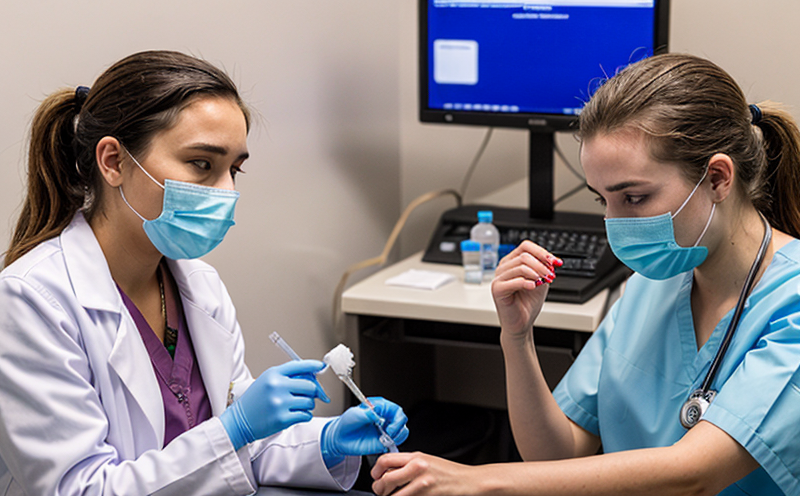FDA BAM Bacillus cereus Detection in Human Samples
The FDA Bacteriological Analytical Manual (BAM) method is a widely recognized protocol for detecting and identifying specific bacteria, including Bacillus cereus. This service focuses on the detection of B. cereus in human samples using this validated method. The importance of such testing cannot be overstated, especially within the context of ensuring public health and safety.
Bacillus cereus, a Gram-positive spore-forming rod bacterium, is known for its ability to produce toxins that can cause foodborne illness. These toxins are particularly relevant in human samples where they could lead to cases of vomiting and diarrhea. By identifying B. cereus through the FDA BAM method, laboratories contribute significantly to preventing outbreaks and ensuring that appropriate measures are taken.
The process involves several critical steps, including sample collection, preparation, inoculation onto selective media, incubation, and final identification based on colony morphology and biochemical tests. Each step requires meticulous attention to detail to ensure accurate results. The FDA BAM method is not only a regulatory requirement but also an essential tool for quality assurance in laboratories.
Our laboratory adheres strictly to this protocol, ensuring that all samples are processed with precision and care. We use the latest technology and equipment to enhance accuracy and reliability. Our team of experts ensures that each step is conducted according to international standards, such as ISO 17025 for quality management systems in testing and calibration laboratories.
The FDA BAM method provides a robust framework for detecting Bacillus cereus in human samples, offering both qualitative and quantitative results. This comprehensive approach allows us to provide clients with the necessary data to make informed decisions regarding public health measures, product recalls, or further investigations into contamination sources.
To summarize, our FDA BAM Bacillus cereus detection service is designed to meet stringent regulatory requirements while providing accurate and reliable results. By leveraging this method, we help protect public health by identifying potential sources of contamination early on in the process.
| Step | Description |
|---|---|
| Sample Collection | Gathering samples from suspected sources using sterile techniques. |
| Inoculation onto Selective Media | Plating samples on media designed to support Bacillus cereus growth. |
| Incubation and Observation | Monitoring the development of colonies over specified time periods. |
| Identification | Determining the presence of B. cereus based on colony characteristics and biochemical tests. |
Applied Standards
The FDA BAM method for detecting Bacillus cereus in human samples is based on internationally recognized standards that ensure consistency and accuracy. The primary standard used is the FDA Bacteriological Analytical Manual (BAM), which provides detailed protocols for sampling, sample preparation, and analysis.
In addition to BAM, we also adhere to other relevant international standards such as ISO 17025 and EN ISO/IEC 17025:2017. These standards provide guidelines on quality management systems in testing and calibration laboratories, ensuring that our methods are up-to-date with the latest scientific advancements.
Our adherence to these standards is crucial for maintaining high levels of accuracy and reliability in all tests conducted. By following such rigorous protocols, we ensure that our results can be trusted by regulatory bodies and industry professionals alike.
Scope and Methodology
The scope of this service includes the detection of Bacillus cereus in human samples using the FDA BAM method. This encompasses various steps from sample collection to final identification, with each step meticulously documented and followed.
- Sample Collection: Careful gathering of samples from potential sources using sterile techniques.
- Inoculation onto Selective Media: Plating the samples on media designed specifically for B. cereus.
- Incubation and Observation: Monitoring the growth of colonies over specified periods.
- Identification: Determining the presence of Bacillus cereus based on colony morphology and biochemical tests.
The methodology ensures that all steps are conducted under controlled conditions to minimize contamination risks. This approach guarantees consistent and reliable results, which are essential for regulatory compliance and public health protection.
Customer Impact and Satisfaction
- Regulatory Compliance: Ensuring that all testing processes meet the strictest regulatory standards, thereby reducing legal risks for clients.
- Patient Safety: Early detection of potential pathogens like Bacillus cereus helps in preventing widespread outbreaks and ensuring patient safety.
- Product Quality Assurance: Providing accurate data that supports the quality assurance processes of pharmaceutical companies and other relevant industries.
- Informed Decision-Making: Offering clear, actionable insights that help clients make informed decisions about public health measures or product recalls.





